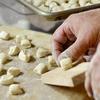Lightly dust your hands with flour to keep the dough from sticking to you. Kneading can be messy, so you should consider wearing old clothes or an apron to prevent flour from getting all over your clothes.
Always keep a measuring cup of flour beside your work area to prevent the dough form sticking to your counter or kneading board.
Place your dough on a well-floured work surface. Grab the side of the dough furthest away from you and fold it toward yourself using your body weight to push the dough into itself. The beginning of the kneading process might require a lot of flour. Be generous to start, but try not to add more than the dough can easily incorporate, or you will throw off the flour-yeast-water-salt ratio.
Pay attention to table/counter height to avoid straining your back. Use a counter or tabletop that allows you to extend your arms to knead the dough while not making you hunch over the table.
 When you knead, you will use only the heels of your hands. Push down on dough with your hand heels. Give the dough a quarter turn (90 degrees). Grab the other side and fold it in half. Again, with a lot of weight behind it, push the newly folded half into itself. Repeat this process until the dough is smooth, silky, and elastic, about ten minutes or more. Don't worry about over-kneading your dough by hand, you have to really work to break down the gluten structure.
When you knead, you will use only the heels of your hands. Push down on dough with your hand heels. Give the dough a quarter turn (90 degrees). Grab the other side and fold it in half. Again, with a lot of weight behind it, push the newly folded half into itself. Repeat this process until the dough is smooth, silky, and elastic, about ten minutes or more. Don't worry about over-kneading your dough by hand, you have to really work to break down the gluten structure.A well-developed dough should be very smooth, with small air bubbles just below the surface. When you've finished kneading, shape the dough into a loose ball. Place the dough in an oiled bowl, turning it over to coat the surface lightly with oil, and let it rest smooth-side up. Cover the dough with a damp kitchen towel or plastic wrap to keep the surface from drying out.
Most bread recipes call for the dough to be “punched down” after it has risen to twice its size. Punching down means to lightly press the dough to express some of the gas. You don't have to fully knead the dough again between the first and second rise. The best method is to use the fingers of one hand and give the dough a few good pokes. Then replace the damp kitchen towel or plastic wrap and let rise until ready to shape and bake.

